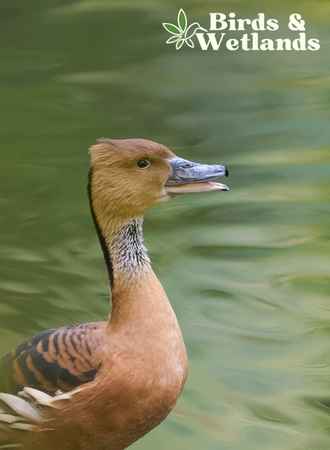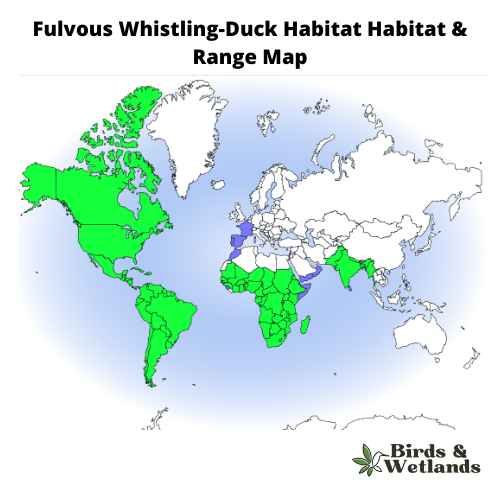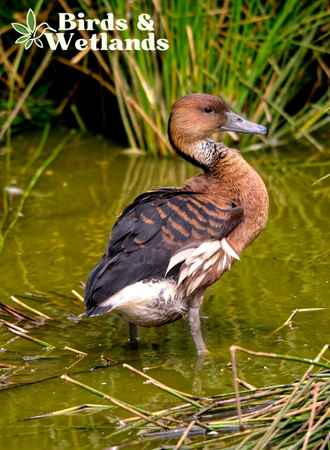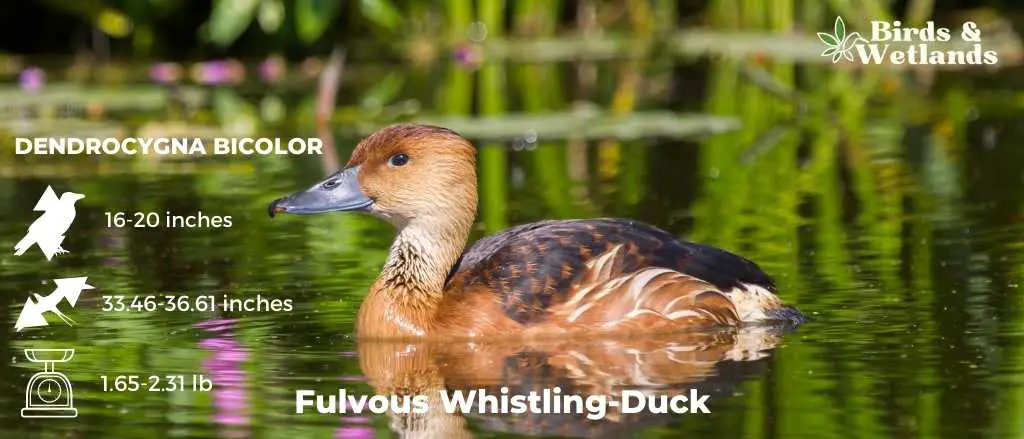The fulvous whistling duck (Dendrocygna bicolor) is a brightly colored waterfowl found in warm freshwater marshes across the Americas, Africa, and Asia.
The name ‘fulvous’ comes from the Latin word for ‘tawny’ or ‘reddish-yellow’, referring to the duck’s reddish-brown plumage.
The duck gets its ‘whistling’ nickname from its distinctive call, which has been described as sounding like a high-pitched whistle.
This duck was once called the “fulvous tree duck” despite not perching as much as other whistling ducks, such as the black-bellied whistling duck.
Like the other seven species of whistling ducks, fulvous whistling ducks are more closely related to swans and geese than to true ducks.
Scientific Name: Dendrocygna bicolor
Order: Anseriformes
Family: Anatidae
Height: 16 to 20 inches (40 to 50 centimeters)
Wingspan: 85 to 93 cm
Weight: 748–1,050 g (26.4–37.0 oz)
Fulvous Whistling-Duck Description
The fulvous whistling duck is a stunning bird, easily recognizable by its rich caramel coloring. Its long neck and legs give it a graceful appearance, and its cinnamon-brown feathers are accented by dark brown wings with a silvery-white stripe on the edges.
The bird’s most distinctive feature is its white rump, visible even when it is in flight. The fulvous whistling duck also has a blue-gray bill, adding to its striking appearance.

Listen to Fulvous Whistling-Duck
As a member of a distinctive group of 8 whistling duck species, fulvous whistling ducks got their name from the high-pitched, whistling sound they make in flight.
Fulvous Whistling-Duck Habitat
Fulvous whistling ducks prefer water habitats like shallow wetlands, marshes, swamps, and lakes. They will also sometimes inhabit agricultural fields, golf courses and flooded rice fields. It is extremely rare to find fulvous whistling ducks in elevated areas, but some flocks have been sighted in the mountains of Peru and Venezuela. These ducks avoid wooded areas.

Fulvous Whistling-Duck Range
The range of the fulvous whistling duck extends across four continents. In the Americas, its breeding range extends from South America in northern Argentina to the southern parts of the United States.
In North America, the fulvous whistling duck populations have been breeding in southern California, along the Gulf Coast, south Florida, southwestern Arizona, and Central and Eastern Texas. Previously, they were vagrant visitors, but they began breeding in the United States at the outset of rice cultivation in the country.
Outside of North America, fulvous whistling ducks have been sighted in Morrocco, Hawaii, India and some parts of east Africa.
Fulvous Whistling-Duck Diet
Fulvous whistling ducks are omnivorous birds that primarily eat aquatic plants. They will also eat waste grain, rice, and grasses that they find while foraging. These birds do not typically migrate, so they can be found in the same location year-round.
Females occasionally eat other small animals, such as aquatic invertebrates, worms, insects, larvae and small fish. They need good protein sources as they prepare for egg-laying.

Fulvous Whistling-Duck Behavior
Like other species of waterfowl, fulvous whistling ducks exhibit distinctive behaviors.
This duck does much of its foraging in damp fields, especially in rice fields in the United States. Interestingly, rice is a small part of their diet. They feed on seeds and weeds growing in the fields.
Moreover, these ducks are diurnal. They are active during the day and night. So, it’s not uncommon to see these ducks feed on plant material in rice-growing areas at night.
These ducks are social birds that tend to congregate in small groups. They often form large flocks when they find a good feeding or roosting location. These flocks can sometimes number in the hundreds or even thousands of birds.
The ducks will remain at one location until the food source is depleted, moving on to another area. Although they are mostly non-migratory, they travel long distances to find suitable habitats with many food sources.
Nesting & Mating Habits
Fulvous ducks mate for life, which means they will pair up with one partner and stay with them until one of them dies. A potential male and female courtship display are relatively simple, consisting of some mutual head-dipping before mating and a short dance after copulation in which the birds raise their bodies side by side while treading water.
Once a pair is established, they can choose to breed alone or in small groups with other pairs. In North America, the breeding season lasts from May to August and coincides with water availability.
The normal clutch size is ten eggs, but it can exceed this number due to brood parasites or egg dumping, which is a common practice among birds. Egg dumping is when a female lays its eggs in another female’s nest.
Both parents incubate the eggs, with the male incubating the eggs longer than the female. The incubation period lasts between 24 to 29 days.
These ducks nest in a wide range of nesting locations, including both natural and artificial habitats. Generally, they prefer to nest in areas with dense marsh vegetation and plenty of food and other vegetation, such as open-water lakes or ponds.
However, they will also use man-made habitats such as rice fields if necessary. They will always build their nest close to the water regardless of where they are located.
The female will build the nest out of plant material such as leaves and stems. She may line the nest with her down feathers, but in most cases, the nest will have little to no soft lining.

Fulvous Whistling-Duck Population & Conservation
The estimated global population of this duck is around 2 million. The conservation status is currently designated as “Least Concern” but the overall population is on the decline, albeit slowly.
In recent decades, climate change, habitat loss and hunting pressure have contributed to the declining population of this duck.
Hunting
Hunting for this duck is not as common as other duck species since their breeding populations are concentrated in the country’s southern parts.
Key Points
- Fulvous whistling ducks (Dendrocygna bicolor) avoid wooded areas and instead settle in areas near water, such as flooded grasslands.
- They have long legs and a brownish-black tail.
- These ducks are gregarious birds that live in loose flocks consisting of family groups and other whistling ducks.
- Unlike other water birds, the males take part in the incubation process.
- These ducks don’t perch on trees, preferring to stay on the ground or in shallow water.
- These water birds prefer to build their nests on the ground with dense vegetation to avoid detection by predators.
- They flock with other birds in the winter to find better food sources.


